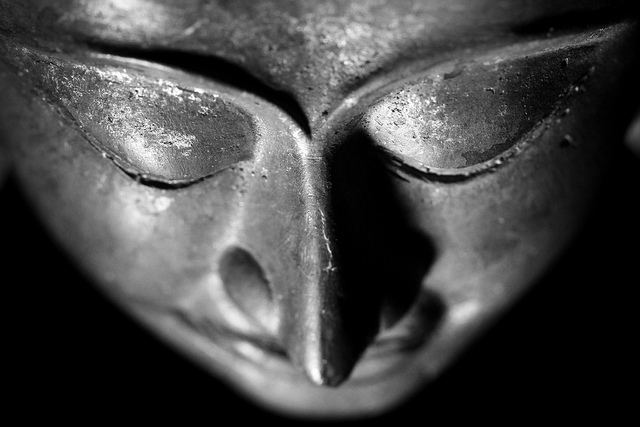
Giving up on things has always been the easiest option to pick, but it is not the only option when we convincingly decide to start something; it’s a choice that we make, and we are drawn towards this because we don’t trust our own actions and decisions at times.
This happens with everyone and is a challenge that I’ve faced throughout my own life, even giving up on the smallest of things—the process to reach where I wanted was always tedious, annoying, hard to follow and involved many tribulations.
In the end, I’d always felt dissatisfied and unhappy because of my lack of perseverance and for not feeling at peace with the Universe and the self.
After many trials, these things eventually came. I found the real meaning of “to reach where I want,” a concept which helped me to carve a defined and progressive path without giving up. The path of acceptance, self-analysis, exploring, implementing and trying harder through the Buddha way, the destination being a consistent state of peace and contentment with the self.
*
While exploring the Buddha way, I realized that the things I was always looking for were already inside me. I realized that the ability to transform lies within myself. I stated taking complete charge of my karma and responsibilities towards the world around me. The Buddha nature is already within us; the tricky part is understanding how to illuminate it.
The journey to Buddha hood is quite simple, but it’s not easy. It’s a continuous process that involves practice, study and faith throughout; and there’s no end to it. The destination in Buddhist practice is not something specific, rather practice and the path followed is the destination itself.
I realized in all these years since I started practicing the Buddha-way that the journey begins with acceptance of things and leads to never-ending happiness and contentment. My way to permanent happiness crossed through various tribulations, but believe me it’s worth it. I practice every day, learn more everyday and enjoy more everyday!
Buddhism says that our karmas determine our life, and that we can transform our negative karmas to positives for better and conscious life ahead.
The journey into Buddhism is not difficult, but it requires three big things: faith, practice and perseverance. Each step has its own importance and we need to touch each step and get over it to reach to the ultimate goal. Buddhism is not religion-specific, but a study of our inner nature, transformations, choosing our karmas and acting upon the teachings of Buddhism.
I define my experience in a 10-step-journey to understand Buddhism as a practice of happiness and contentment, and moreover, self-growth. This can help us to look at the process in a compressed form.
The details get explored when we actually follow these steps.
Step 1: Reality Check
We don’t believe that we might have done something wrong in the past; we question our karmas and think, “why is this happening to me when I haven’t wronged anyone?”
The Buddhist teachings (or the first step of the teachings) make us learn to hold ourselves responsible for all that’s happening in our life. Our karmic cycle is what makes us happy or makes us suffer. All those whom we hold responsible for our sufferings have no role to play in deciding the consequences of our bad karmas or good karmas.
This is the most difficult step to take and understand, to move ahead towards Buddhahood.
Step 2: Decide to Kickstart or Back off
Now, we either accept (by analyzing or not analyzing, initially), or remain onto our own judgment and skip or keep questioning faith.
If we accept and move on, in the long run we might get answers of all we questions and doubts we had in the beginning. And if, we skip or remain only own our own judgment, we would not find any escape out of our sufferings.
So, we need to decide!
Step 3: Acceptance
To find acceptance, we need to consider ourselves as normal human beings, understanding that it’s natural to make mistakes. We have to be willing to make changes to better ourselves.
There is no need to analyze (at this point) what we have done wrong.
Be firm on the decision to change all negative karmas (thoughts, words, decisions, and actions) into positive ones to clean up our karmic cycle.
We need to accept our bad aspects and practice faith, determination, good words, positive thoughts and actions to incorporate the changes we are aiming for.
Step 4: Practicing
We must start practicing faith without judgment and without looking for instant results.
(But if we think deeply and analyze, we know that have already started receiving the instant results of our decision of keeping on with the faith, in the form of peace that we found after accepting ourselves and continuing with the faith.)
Step 5: Feeling Positive
Gradually we start realizing that acceptance is the first step towards peace and positivity. We also start analyzing things now, which we left in the initial few steps. A lot of things will cross our mind and we would be able to understand the difference between right and wrong.
We also might get some events or incidents of the past in our head which we might relate to our present condition. Here, we get the real picture of analyzing what is positive and what is negative.
Step 6: Having Answers to Our Questions
Now, we will not question the circumstances, or situations, but we’ll look for answers, to come out of these low life conditions, and every time we will get the same answer, “Keep faith, do positive, think positive, be patient! Everything will come to we in due season, but we must not get impatient.”
Keep practicing; limit your dependency on people, situations, or things.
Dig in yourself and connect to faith every time you feel good or bad.
Step 7: Vigorous Practice
We will start practicing more in desire to achieve peace and happiness. We will look for better ways of dealing with things. We will let go of a lot of things and also receive a lot of things while practicing faith. Our karmas will start to transform and we will start appreciating even the smallest positive change in our life.
Contentment starts here.
Step 8: Contentment
Now we don’t hold others responsible for our happiness or suffering. We practice to improve ourselves. We also help others to understand the value of happiness within them. Here our life starts escalating from low life condition to high life condition within no time.
Step 9: Results
Now we have achieved peace, love, and contentment within ourselves, and have only faith to rely on. We don’t practice to have something new; we practice to be happy with all that we have. We have mastered the art of turning to faith to handle hard times.
Step 10: Happiness
We keep being happy and inspiring others, seeking new opportunities to grow our faith in hard times.
The key to this journey is perseverance!
Author: Deepika Tuli
Editor: Renée Picard
Photo: stephcarter at Flickr










Read 0 comments and reply